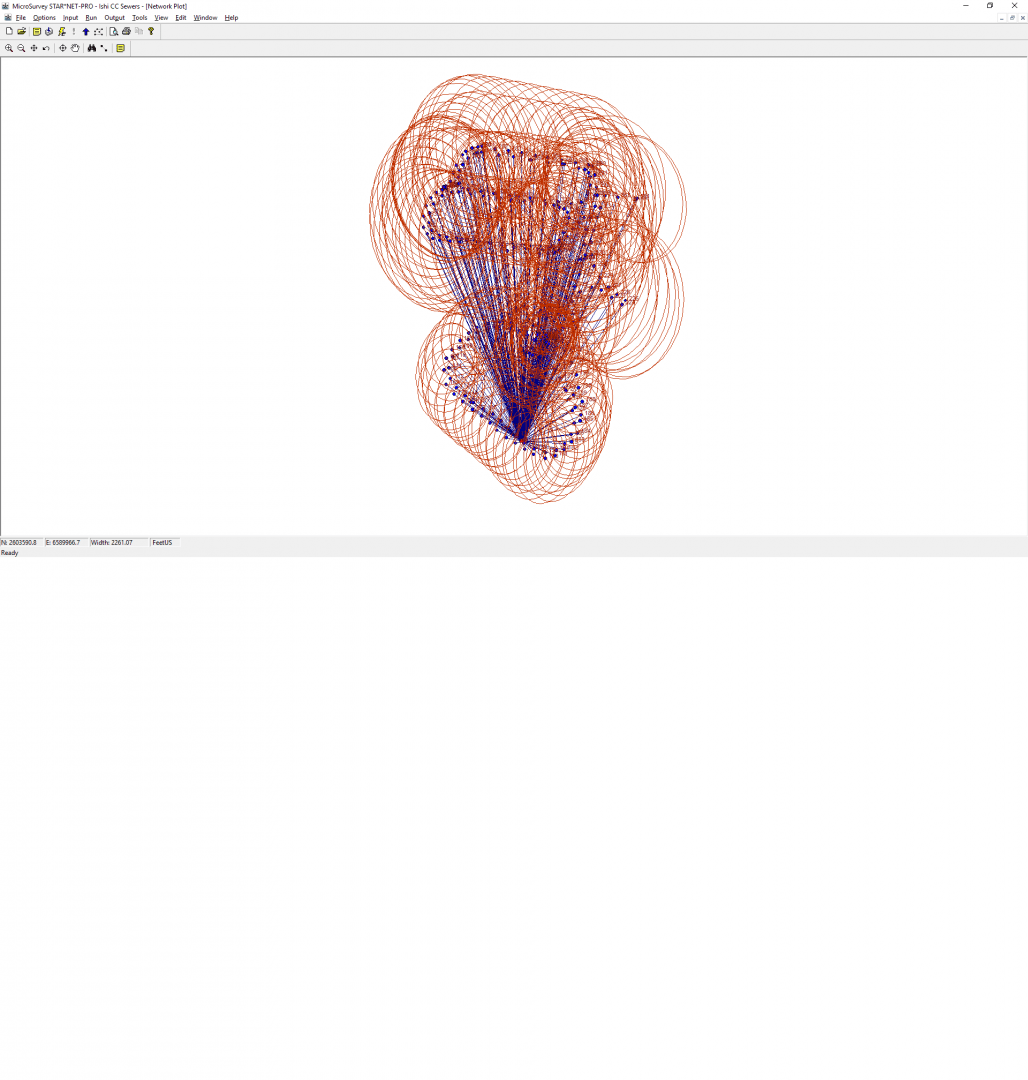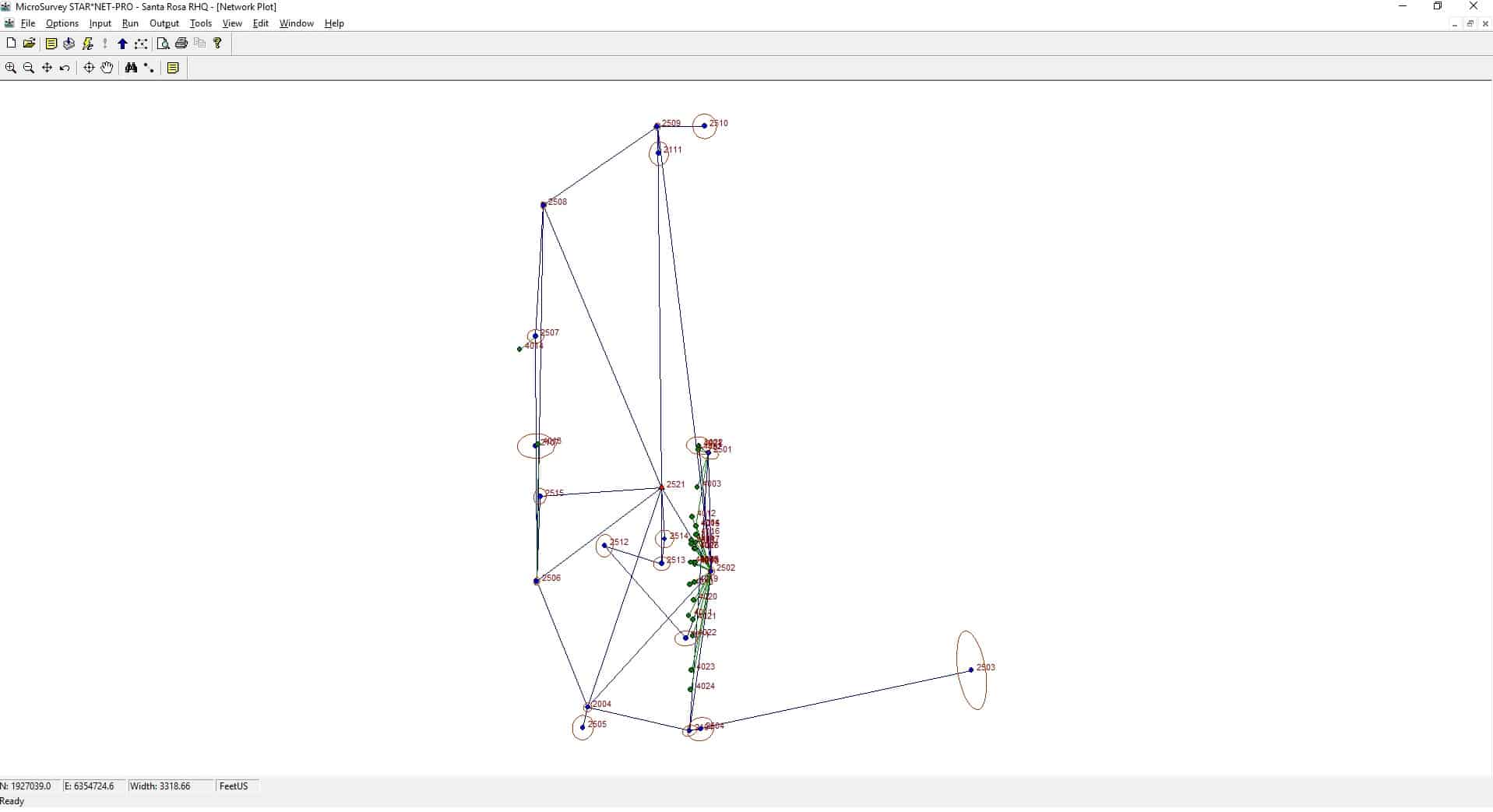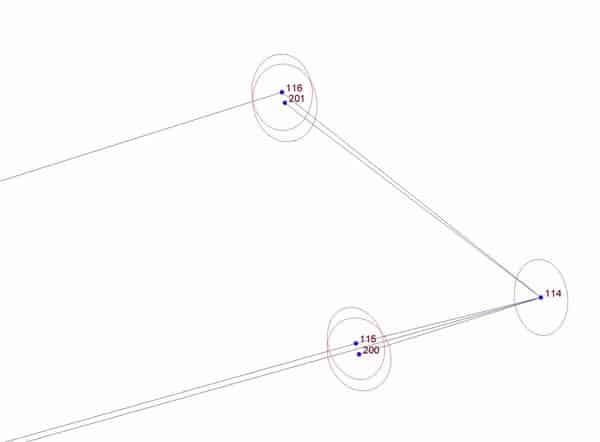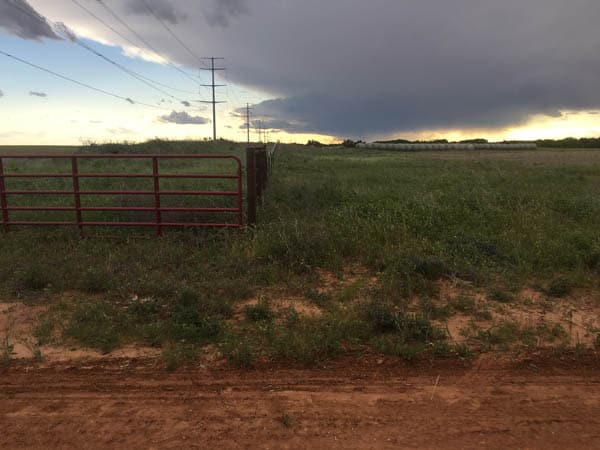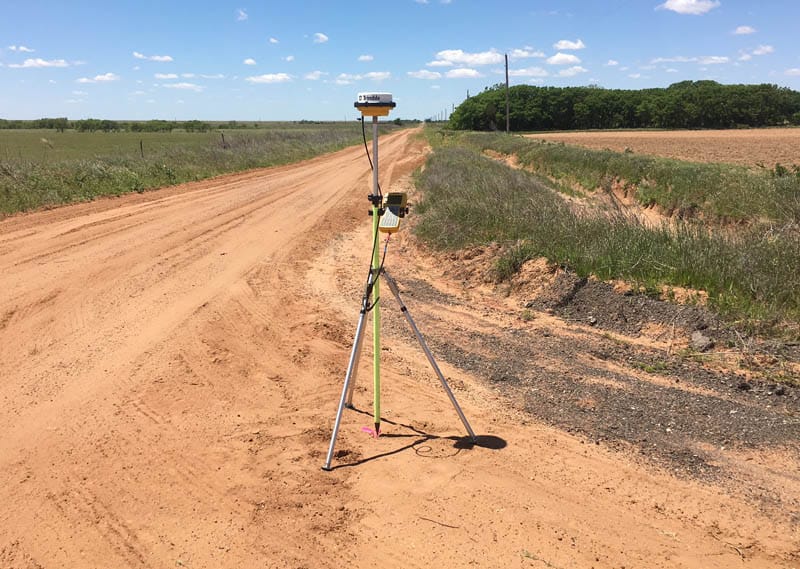And here I thought you bought your grandson a Hasbro Spirograph toy! 🙂

That is coming soon!
Dave Karoly, post: 427485, member: 94 wrote: I mostly find this humorous, co-worker thinks I should print and frame it:
You realize that you can control the scale of the error ellipses as one of the parameters in the Plot Options, right? If RTK vectors are properly collected, they should be measurements, if possibly of indeterminate quality.
Kent McMillan, post: 427528, member: 3 wrote: You realize that you can control the scale of the error ellipses as one of the parameters in the Plot Options, right? If RTK vectors are properly collected, they should be measurements, if possibly of indeterminate quality.
Yes I knew that.
I mostly keep the ellipse graphics turned off, as i find them distracting. I pay attention to the adjustment stats, and if they look good I don't often need to see the ellipses.
Jim Frame, post: 427539, member: 10 wrote: I mostly keep the ellipse graphics turned off, as i find them distracting. I pay attention to the adjustment stats, and if they look good I don't often need to see the ellipses.
While I agree that the numerical uncertainty estimates such as the standard errors in N, E, and Up components tell the story best, I also like to examine the network plot with error ellipses turned on to spot obvious problems.
Here's a plot of a network from the recent work in two counties at the edge of Oklahoma. The basic control scheme was a starburst pattern of radials surveyed by PPK GPS from a control point connected to NAD83 via OPUS. The uncertainty in the OPUS-derived position is propagated into the uncertainties of the points in the network.
The network contains some ties that I consider to be critical and others that for various reasons are not, but looking at the thing as a whole gives a reasonably good picture of the overall uniformity of positioning quality, identifying a few points with somewhat larger uncertainties that can be inspected just by clicking on the point on the output plot.
I like the results to show ellipses when they are beyond my error setting of 0.03'.
A Harris, post: 427578, member: 81 wrote: I like the results to show ellipses when they are beyond my error setting of 0.03'.
That's not an automatic setting is it? You do that manually, if you see some over .03'?
Kent McMillan, post: 427546, member: 3 wrote: While I agree that the numerical uncertainty estimates such as the standard errors in N, E, and Up components tell the story best, I also like to examine the network plot with error ellipses turned on to spot obvious problems.
Here's a plot of a network from the recent work in two counties at the edge of Oklahoma. The basic control scheme was a starburst pattern of radials surveyed by PPK GPS from a control point connected to NAD83 via OPUS. The uncertainty in the OPUS-derived position is propagated into the uncertainties of the points in the network.
The network contains some ties that I consider to be critical and others that for various reasons are not, but looking at the thing as a whole gives a reasonably good picture of the overall uniformity of positioning quality, identifying a few points with somewhat larger uncertainties that can be inspected just by clicking on the point on the output plot.
Kent,
That is quite a network to propagate from a single OPUS derived point. It appears you had multiple opportunities to derive other OPUS points. If not that, the reoccupation of your base OPUS point should have tightened up it's position.
Paul in PA
Paul in PA, post: 427600, member: 236 wrote: Kent,
That is quite a network to propagate from a single OPUS derived point. It appears you had multiple opportunities to derive other OPUS points. If not that, the reoccupation of your base OPUS point should have tightened up it's position.
Well, the OPUS-derived position has a standard error less than 0.01 ft. in N and E components, less than 0.02 ft. in Up. It was derived from slightly more than EIGHT HOURS of observations logged at a station that is completely unobstructed. While it is true that I could have run another 8 hr session on that same control point, the "improvement" would have been on the order of a millimeter, which would be a negligle return that would not have appeared in the final uncertainties of the points positioned when you consider that the standard errors in the radial vectors, the longest of which was only about three miles, were about 5mm in N and E components.
The most critical positions were those four monuments that I set and those all ended up with uncertainties of less than 5mm in N and E with respect to NAD83 as realized by the CORS network (with much better local uncertainties). That is already too good for a survey like that, but it was easy to do. Someone who wants to spend time shaving a millimeter or two off of the 5mm uncertainties is certainly welcome to do it, but I wouldn't consider it to be time well spent on that project.
I usually use a single OPUS position and use the other OPUSable points in the network as a check (e.g. I have a long session that I send in). The extra coordinates from OPUS can be inputted into StarNet as free stations and StarNet will show the deltas. I'm not a geodetic surveyor, mostly I care about local point-to-point measurements positioned in the world so they can be plotted in Google Earth, etc.
Normally StarNet doesn't show error ellipses on conventional sideshots but TBC exports RTK shots as GNSS vectors with error estimates so I get error ellipses on those although they are just topo shots.
Paul in PA, post: 427600, member: 236 wrote: Kent,
That is quite a network to propagate from a single OPUS derived point. It appears you had multiple opportunities to derive other OPUS points. If not that, the reoccupation of your base OPUS point should have tightened up it's position.
Paul in PA
The numbers look better without all that redundancy.
Kent McMillan, post: 427605, member: 3 wrote: Well, the OPUS-derived position has a standard error less than 0.01 ft. in N and E components, less than 0.02 ft. in Up. It was derived from slightly more than EIGHT HOURS of observations logged at a station that is completely unobstructed. While it is true that I could have run another 8 hr session on that same control point, the "improvement" would have been on the order of a millimeter, which would be a negligle return that would not have appeared in the final uncertainties of the points positioned when you consider that the standard errors in the radial vectors, the longest of which was only about three miles, were about 5mm in N and E components.
The most critical positions were those four monuments that I set and those all ended up with uncertainties of less than 5mm in N and E with respect to NAD83 as realized by the CORS network (with much better local uncertainties). That is already too good for a survey like that, but it was easy to do. Someone who wants to spend time shaving a millimeter or two off of the 5mm uncertainties is certainly welcome to do it, but I wouldn't consider it to be time well spent on that project.
Kent,
My apologies for agreeing that you had a network, when instead you had an array. That base is sufficient for an array. A network implies that some or all your positions where also networked to other positions. I do not do arrays, essentially radial stakeout, so my comment was off base and not relevant to my experience.
Paul in PA
MightyMoe, post: 427611, member: 700 wrote: The numbers look better without all that redundancy.
Not if the a priori estimates of the uncertainties are realistic, which was the entire point of a lengthy inquiry into the weighting of RTK vectors.
In the case of the PPK vectors, some redundancy does provides an efficient check upon process quality, i.e. tests the vector weighting scheme.
Paul in PA, post: 427615, member: 236 wrote: My apologies for agreeing that you had a network, when instead you had an array.
You're welcome to call it whatever you like, but it is an efficient way of obtaining accurate NAD83 positions with realistic uncertainty estimates. Professional surveying involves making measurements with well-characterized uncertainties and making realistic estimates of the uncertainties in the positions derived from them. It is true that one could turn any survey into a hobby activity, but when the uncertainties between points positioned by the survey already meet the most stringent ALTA/NSPS standards for positional accuracy, that doesn't strike me as a really productive idea.
Paul in PA, post: 427615, member: 236 wrote: Kent,
My apologies for agreeing that you had a network, when instead you had an array. That base is sufficient for an array. A network implies that some or all your positions where also networked to other positions. I do not do arrays, essentially radial stakeout, so my comment was off base and not relevant to my experience.
Paul in PA
It's like an open ended traverse or a hinged closed traverse.
Dave Karoly, post: 427609, member: 94 wrote: I usually use a single OPUS position and use the other OPUSable points in the network as a check (e.g. I have a long session that I send in).
I myself prefer to reoccupy the same control point for which an OPUS solution was derived. There are several reasons for this, among them that usually the OPUS point is in a secure, very open location, but the main one is that the repeat occupations give a way to test the scalars that are applied to the variances and covariances OPUS reported for each solution. Demonstrating that a scalar (GPSFACTOR in Star*Net) of, say, 2.5 in horizontal components produces an adjustment of repeat occupations that consistently passes the Chi Square test is an important result with wider implications as to process quality.
MightyMoe, post: 427619, member: 700 wrote: It's like an open ended traverse or a hinged closed traverse.
Not really. It's more like turning the same angle and measuring the same distance so many times that the uncertainty in the results drops to below 5mm s.e.
Here, for example is a part of the plot showing three points positioned via GPS vectors that were then validated by conventional measurements between them when the Rod and Caps 200 and 201 were set with the instrument at 114.
Rod and Cap 200 fell near the fence corner post seen in this photo (taken late in the day, not during thunderstorm activity), which gives a pretty good idea of the general setting of the survey, as does the one below it. It should be unsurprising that GPS vector solutions in that environment are very good.
